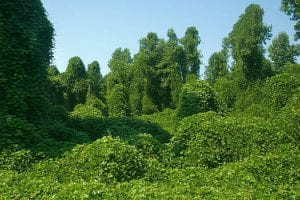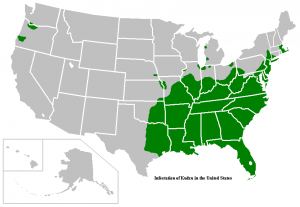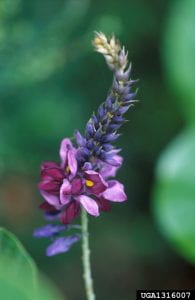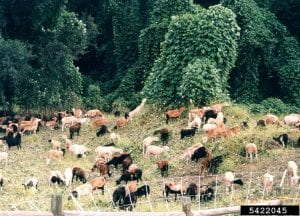The Story of Kudzu: From Exotic Rarity to Unwanted Invasive
By Cecille Jones, Monroe Master Gardener Volunteer
This article appeared in the December 2020 / January 2021 Issue of Gardening in Orange County.

Today, we know kudzu (Pueraria montana) as an invasive vine, an unwanted interloper. Nicknamed the Vine That Ate the South or the foot-a-night vine, poet James Dickie labeled it a vegetable form of cancer.
This climbing vine flourishes in the Southeast, where heat and humidity provide a paradise for the perennial legume. Today, kudzu has covered millions of acres of land, trees and abandoned buildings and has been spotted as far north as New York and Massachusetts. Non-native and aggressive, kudzu can lead to the extinction of native plants, destroy biodiversity and permanently alter habitats.

As reviled as it is today, kudzu’s reputation didn’t start out that way. Kudzu made its American debut in 1876 at the Philadelphia Centennial Exposition. Thirty-seven countries participated in the 100-year celebration of the signing of the Declaration of Independence, and nearly 10 million people showed up. At the Japanese pavilion, people admired the exotic rarity called kudzu.

From there, kudzu was marketed in the Southeast as an ornamental vine meant to shade porches with fragrant flowers. By the 1920s, Charles and Lillie Pleas of the Glen Arden Nursery in Florida discovered that animals would eat kudzu and so they promoted it as forage as well.
A decade later, severe drought and incorrect farming methods helped to create the Dust Bowl. Turning to kudzu to control soil erosion and feed cattle, the government distributed up to 85 million seedlings and paid farmers as much as $8 an acre to plant kudzu. By 1946, there were three million acres of kudzu.
Meanwhile, Channing Cope became the plant’s most famous advocate. Through his daily radio program, he promoted the virtues of “the miracle vine.” At the height of its popularity, there were kudzu beauty contests, clubs, and even recipes.
Much to Cope’s disappointment, in 1953, the USDA removed kudzu from its list of recommended cover plants. By 1970, it was classified as a weed. Seven years later, kudzu made the Federal Noxious Weed List.
 Today, the cost to control and combat this invasive plant runs in the millions of dollars annually. From herbicides to persistent clearing, scientists have also discovered that Angora goats take to kudzu like candy. Perhaps it’s time to call in the goat busters?
Today, the cost to control and combat this invasive plant runs in the millions of dollars annually. From herbicides to persistent clearing, scientists have also discovered that Angora goats take to kudzu like candy. Perhaps it’s time to call in the goat busters?
Read more about Kudzu
Kudzu – New York Invasive Species Information
Lessons Learned from Six Years of Kudzu Research – New York State Integrated Pest Management Program
The True Story of Kudzu, the Vine That Never Truly Ate the South – Smithsonian Magazine
